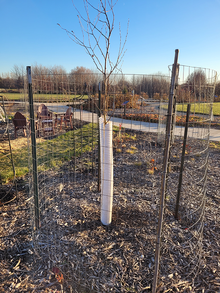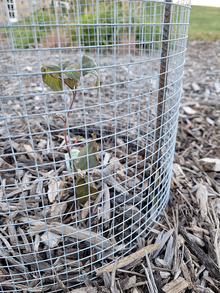Winter weather is tough enough on plants - the wind, dryness and cold. Animals also struggle to survive, searching for shelter and food, sometimes in our own backyards. The damage caused by animals might only be cosmetic at times, but it can also have long-term effects on plants - even killing them.
Animal damage and its impacts
Animals such as mice, rabbits, voles and deer feed on the twigs, bark, leaves and stems of shrubs and trees. They may nip off terminal buds, eat shrubs to the ground and girdle trees and shrubs by chewing through bark.
Girdling occurs when an animal chews through the bark and cambium layer beneath the bark, damaging the plant's vascular system. This inhibits the transport of water and nutrients, resulting in partial dieback or plant death.
Your best strategy is fencing and guards
While not always aesthetically desirable, the best overall strategy to protect plants is to create physical barriers, usually fences. Fence plants with sturdy fencing - enclosing all the branches of a shrub and the lower branches and trunk of a tree. Hardware cloth is a good choice for keeping out smaller animals.
Tree trunks can be protected with tree guards (white corrugated plastic tubes) or hardware cloth around the trunk 12 inches larger than the trunk or shrub diameter. Tree guards also reflect the winter sun and protect the tender bark from splitting.
When setting up fencing, bury the bottom 2-3 inches in the soil to keep out small, burrowing animals like mice and voles. To exclude rabbits, ensure your fencing is at least 18-24 inches above the anticipated snow line. Taller is better. Rabbits are lightweight and can sit atop snow and feed on branches above the fencing. We had record snow depth last year, and even 4-foot fencing wasn't tall enough to prevent rabbit browsing!
Throughout the winter, check often to make sure rabbits haven't somehow gotten inside the fencing. Tree guards can be removed in spring. If animal browsing is a problem during the growing season, feel free to leave the fencing in place year-round.
Make your yard inhospitable to animal browsers
In addition to fencing, make your yard as inhospitable to browsers as possible. Start by eliminating nesting habitat and protective cover like brush piles, and fence off protective and nesting areas under structures like decks. Within 2 feet of young trees, cut down grasses and other vegetation in late fall to reduce protective cover for mice and voles that might feed on trunks and stems.
Repellents may be a more economical solution to fencing/screens and wraps. They can also be used in conjunction with fencing. Note that repellents are not poisons - they make plants taste or smell bad to animals. Repellents can be sprayed or painted on trees and shrubs; one application is usually enough for the entire dormant season.
In spring, start applying repellents early in the season to train animals not to feed in your yard, and re-apply repellents after rain/irrigation. You will also want to change up your repellent selection, as animals can become accustomed to them after a while.
Learn more about protecting trees and shrubs in winter.
Fencing/exclusion guidelines for deer
If you garden in an area that has a deer population, you have experienced the damage deer can inflict on plants. While some plants are noted as “deer resistant," deer will eat anything if they are hungry, and fawns will try anything once. Deer feed on the terminal and side branches of small trees and shrubs. They can also damage bark by rubbing their foreheads and scraping their antlers to remove the “velvet” on tree trunks in late summer and early fall.
Things to consider when fencing for deer
- Minimum 8 feet high
- Well-constructed, sturdy fencing material
- Bud cap terminal buds of young evergreens
- Micro-enclosures
Permission is granted to news media to republish our news articles with credit to University of Minnesota Extension. Images also may be republished; please check for specific photographer credits or limited use restrictions in the photo title.




